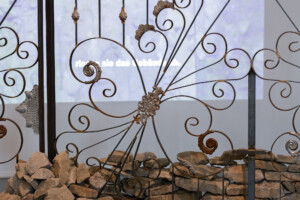Excerpt from Michel Sicard: Nadia Kaabi-Linke and the Trajectory of Migrants
In: Barbara J. Scheuermann, Nadia & Timo Kaabi-Linke (Ed.), Versiegelte Zeit (Sealed Time). Bielefeld, 2017, p. 41f.#
In opposition to times that flow—those of history, genealogies, and ideologies—Nadia Kaabi-Linke proposes breaking duration down into instants to be taken as visual testimony with respect to their skin, their grain, in order to evaluate their intrinsic tonality and then to gather them together. This is clear in everything she has realized with regard to the cobblestones, the paving stones that are pieces of patched history, as if to harass the time of passages but also to break them down meticulously. The deconstruction of vision requires fragmentation, succession, serialism. These accumulated segments of time taken in haste, or pieces of time saved from logical, military, or humanitarian catastrophes are subsequently reassembled into new continents.
Color of Time – Seq’17 (2017) thus indicates the squares of color as occupied, admittedly reproduced in what is nevertheless an act of vital and rigorous observation upon the facades of buildings of historical families that have become museum-like edifices in Tunis, Kiev, Berlin. The artist endeavors to reproduce these indestructible colors which have spread all the way to us and now appear like abrasive surfaces before our misty eyes—their grain is quite enlarged, as if seen beneath a magnifying glass—in resemblance to sandpaper, but which will subsequently work together in a complex game analogous to playing cards in order to connect not figures, but quite diverse spaces in aerial trajectory, formative network, musical scale, or mental territory. These cards simulate a new game which is not the time of narratives, of places, of earthly pedestals, of exchanges, or of success but instead of obsessions, of traumas, of compulsive fears, of moments that are privileged and forgotten, covered over by the time of generations.
Because history becomes worn out and uses our walls, our tools, and even our representations. It is sometimes necessary to recreate—past the crackles and scales of roughcast—what had particular characteristics during its time, in its inexpressible taste and its coarse and palpable grain. In the work, these long-gone times are reborn, bursting like bubbles on the surface of our current lives. They hide the patina that is not something obscure and nebulous but is stratified time, that which the Japanese call sabi, the beauty that comes with age, in a rust that snatches it away from both functionality and abstraction and rummages beneath the apparent layer in search of enfolded time. These dull surfaces resonate in an impermanent and noble conception that translates a slide towards nothingness.
– Dr. Michel Sicard is Professor Emeritus for architecture, applied arts, epistemology, and aesthetics at Sorbonne University.

































